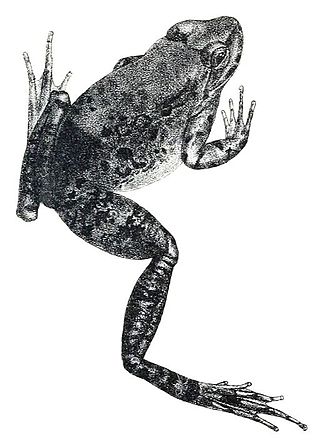
Salamandridae is a family of salamanders consisting of true salamanders and newts. Salamandrids are distinguished from other salamanders by the lack of rib or costal grooves along the sides of their bodies and by their rough skin. Their skin is very granular because of the number of poison glands. They also lack nasolabial grooves. Most species of Salamandridae have moveable eyelids but lack lacrimal glands.

The Rhacophoridae are a family of frogs that occur in tropical sub-Saharan Africa, South India and Sri Lanka, Japan, northeastern India to eastern China and Taiwan, south through the Philippines and Greater Sundas, and Sulawesi. They are commonly known as shrub frogs, or more ambiguously as "moss frogs" or "bush frogs". Some Rhacophoridae are called "tree frogs". Among the most spectacular members of this family are numerous "flying frogs".

Leptobrachella is a genus of frogs in the family Megophryidae. Members of Leptobrachella are found throughout Asia including on Borneo and the Natuna Islands. They are sometimes referred to as Borneo frogs, slender-armed frogs, or dwarf litter frogs. The genus contains over 82 species with 25 found in China alone.

The Rhacophorinae are a subfamily of frogs in the family Rhacophoridae. They range from tropical Africa and Asia to temperate China and Japan.

Polypedates is a genus of frogs in the family Rhacophoridae, the shrub frogs and Paleotropic tree frogs. They belong to subfamily Rhacophorinae. Members of this genus are collectively known as whipping frogs. They occur in eastern and southern Asia.

Amolops is a genus of true frogs native mainly to eastern and south-eastern Asia. These frogs are closely related to such genera as Huia, Meristogenys, Odorrana, Pelophylax and Rana, but still form a distinct lineage among the core radiation of true frogs. They are commonly known as "torrent frogs" after their favorite habitat - small rapid-flowing mountain and hill streams - but this name is used for many similar-looking frogs regardless of whether they are loosely related.

Nanorana is a genus of dicroglossid frogs. They are found in Asia, from the Himalayan region of northern Pakistan and northern India, Nepal, and western China east to montane southern China and southeast to Myanmar, Thailand, Laos, and northern Vietnam. Common names of these frogs reflect the complex taxonomic history of the genus and include Yunnan slow frogs and High Himalaya frogs.

Leptolalax is a genus of frogs in the family Megophryidae. They are sometimes known as Asian toads, metacarpal-tubercled toads, or slender litter frogs, although many species-specific common names do not follow these conventions, and many species do not have common names. They are widely distributed in southeastern and eastern Asia, from southern China and northeastern India to the Malay Peninsula and Borneo. Leptolalax are typically small and have a cryptic colour pattern and no obvious morphological characters useful in systematic studies. Consequently, both molecular genetic analyses and analysis of advertisement calls by male frogs have been important in identifying new species.

Tylototriton is a genus of newts known as crocodile newts or knobby newts. About 38 known species are in this genus. Many species have been described just recently. They range from northeastern India and Nepal through Burma to northern Thailand, Laos, Vietnam, and southern China.

Scutiger is a genus of toads in the family Megophryidae. Common name lazy toads has been coined for them. They occur in China, Burma, Nepal, and northern India in high-altitude habitats. Most are endemic to China.

Kurixalus naso, also known as uphill tree frog, long-snouted treefrog, and Annandale's high altitude frog, is a species of frog in the family Rhacophoridae. It is found in northeastern India, southern Tibet, and Bhutan. A related but unnamed species is found in Myanmar and Yunnan (China). Furthermore, it is possible that Kurixalus yangi is a junior synonym of Kurixalus naso.

Gracixalus is a genus of shrub frogs from south-eastern Asia.

Kurixalus berylliniris is a species of tree frog in the family Rhacophoridae. It is endemic to Taiwan and occurs in the eastern part of the island at moderate elevations. Before its description in 2016, it was confused with Kurixalus eiffingeri. The specific name berylliniris combines the Latin words beryllin and iris, in reference to the green iris of this frog.

Kurixalus wangi is a species of tree frog in the family Rhacophoridae. It is endemic to Taiwan and occurs in the southernmost part of the island. Prior to its description in 2016, it was confused with Kurixalus eiffingeri. The specific name wangi honors Wang Ching-Shong, a pioneering herpetologist from Taiwan.
Kurixalus absconditus is a species of frog in the family Rhacophoridae. It is endemic to West Kalimantan, in the Indonesian part of Borneo near the village of Piasak; it is likely to occur more widely. The specific name absconditus is Latin for "disguised", "concealed", or "hidden", and refers to this species remaining "undetected" within the Kurixalus appendiculatus group. Common name Piasak-frilled swamp treefrog, also spelled Piasak frilled swamp tree frog, has been coined for it.

Zhangixalus is a genus of frogs in the subfamily Rhacophorinae, family Rhacophoridae. They are collectively known as Zhang's treefrogs. They occur in the Eastern Himalayas, southern China, Taiwan, Japan, and southeast Asia.

Boulenophrys is a genus of frogs in the family Megophryidae. They occur in the China, Mainland Southeast Asia and Northeast India. It had been placed variously as a subgenus or synonymy of Megophrys. Dubois, Ohler and Pyron first recognized that Panophrys is preoccupied and employed Boulenophrys as the generic name rather than Tianophrys under the Principle of First Revisor.
Kurixalus motokawai, the Kon Tum frilled tree frog, is a species of frog in the family Rhacophoridae. It is endemic to Vietnam's Annamite Mountains. It has been observed between 1050 and 1400 meters above sea level.















